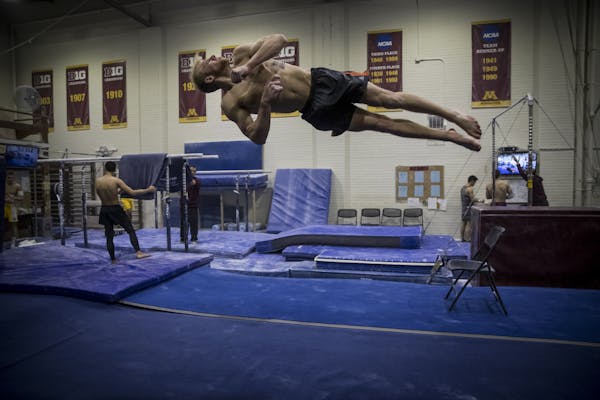 See
more of the story
See
more of the story
The University of Iowa's 2020 football visit to Minneapolis came on Nov. 13, which was the precise 66th anniversary of another Hawkeyes invasion that still will be referred to as the "Bob McNamara Game" by the oldest generation of Gophers followers.
"My dad would say, if not for that kick return against Iowa, nobody would've heard of me," said Anne Marie McNamara-Rogers, one of three McNamara siblings.
That was a display of Hastings humility for McNamara, as he received All-America status as a running back in that senior season, when Ohio State's Howard "Hopalong" Cassady and Wisconsin's Alan "The Horse" Ameche — both Heisman winners — were part of the competition.
As has been mentioned ad nauseam, that 22-20 victory over Iowa in 1954 was my first Gophers game, a 9-year-old kid kneeling on the back line of the closed end zone as part of Memorial Stadium's overflow crowd of 65,464.
McNamara's run for the ages was an 89-yard kickoff return when he burst into a mass of Hawkeyes before midfield, came out the other side and went the distance to break a 7-7 tie in the first half.
Post-college, Bob played four seasons for the Winnipeg Blue Bombers, a couple for the Denver Broncos in the fledgling AFL, and returned to Minnesota to spend more than a half-century as a relentless booster of Gophers athletics.
McNamara died in July 2014 at 82. He left behind a zealous group of Gophers football fans, wife Annette, and Bob Jr., Anne Marie and Susie, and spouses, grandkids, etc.
"We sat in a section in the new stadium [TCF Bank] with Dick Ames and other boosters that lived and died with the Gophers," Anne Marie said. "I kept thinking last season, when we went 11-2, how great it would've been to be sitting there with Dad and seeing his happiness over some of those wins."
How would it have been if Bob still was with us, and the usual numbers of fans had been allowed in the stadium on this Friday the 13th, watching Iowa 35, Gophers 7?
"Eternal optimist, but that would've been tough for him," Anne Marie said. "When things went bad for the Gophers, a lot of people in our section would turn and look at Dad for an explanation. He would say, 'I don't know. I'm not the coach.' "
As disappointing as that 66th-anniversary effort vs. the Hawkeyes would've been for Bob McNamara, it would not be close to the No. 1 heartbreak offered up by the Gophers in recent months.
The football great turned to court sports — tennis, handball, racquetball — after his playing career was over. Soon, Bob became an ardent booster of the Gophers men's tennis team, as well as football.
Bob's brother Dick, known to all as "Pinky" as a Gophers football player, became hugely successful in business. Thus, Bob's first visit when embarking on various Gophers fundraising efforts was always to Pinky.
"Uncle Pinky and Dad were so close," Anne Marie said. "There were six McNamara boys, but Pinky and Dad were a year apart, and they did everything together."
McNamara started a tennis tournament in 1970 to raise scholarship money and other funds for the men's team. The Baseline Club became the booster group for men's tennis, and McNamara ran the tournament for 44 years. It still has existed with family involvement as the "Bob Mac" tournament at Interlachen since his death.
Bob and longtime coach Jerry Noyce had a bond of mutual admiration. The ultimate goal was to build a tennis facility for the Gophers. That occurred with the opening of Baseline Tennis Center adjacent to Ridder Arena, the women's hockey facility, in 2002.
The project cost $20 million, with $5 million spent on the tennis center. McNamara came up with a charitable, four-bar pulltabs operation in northeast Minneapolis that raised the final $1.7 million for the tennis center.
"He would go to the four bars every day — his, plus Frank's, Waldo's and the 200 Club — to pick up the proceeds," Anne Marie said. "His dedication to giving tennis a first-class place on campus was incredible."
There are eight athletes on the 2020-21 Gophers men's team. They share 4½ scholarships that are fully endowed. There remains $1.2 million in that endowment fund. The cost of men's tennis last school year was $770,000 out of a budget of $125 million.
McNamara's magnificent legacy first as a football all-timer and then as a booster-for-life earned 15 minutes of notice in September from athletic director Mark Coyle to the tennis players.
"Your sport is being dropped," he said. "The decision is final."
That announcement came on Sept. 10 — men's tennis, with its .61% of the budget, was gone, along with men's gymnastics and men's track, both indoor and outdoor. A month later, men's outdoor track was saved right before a Board of Regents meeting, leaving men's tennis, gymnastics and indoor track as the cuts.
Eight tennis athletes. A coach and an assistant. Alums who have found large success in business, in professional careers, in medical careers — and often donors to the university.
Whoosh. Gone.
Pinky funded much of the alumni center kitty-corner from TCF Bank Stadium. He made a large donation to the new stadium, and Bob was tireless in finding donors to get football back on campus (since 2009).
And nine years earlier, when the Baseline Center opened, Bob said to his family: "Thank God our tennis program now can't be eliminated."
He was wrong. A program that provided a facility for all tennis players on campus being dropped to reduce the number of male athletes by eight. Eight.
"Coyle has told us the only way tennis stays is if we come up with $15 to $18 million to endow the program in perpetuity," Anne Marie said. "All the tennis people are trying. Obviously, we need a big benefactor."
Coach Murray Warmath, in his first Gophers season in 1954, said of McNamara's kickoff return vs. Iowa that it was the "greatest example of one man against 11" he had seen in football.
The McNamara family and the tennis boosters face even longer odds than Bob did on that late-fall Saturday against the full might of the Hawkeyes.
And this McNamara, a great Gopher in every sense, would be beyond saddened to see the elimination of a sport requiring so little and that he found worth so much of his energy.




